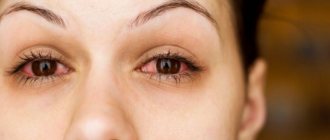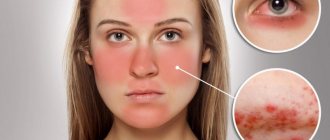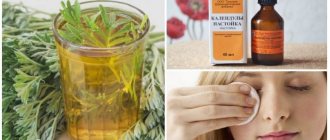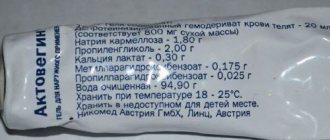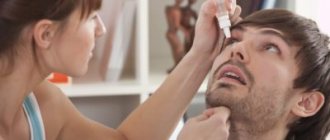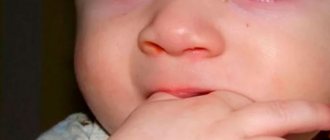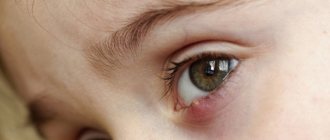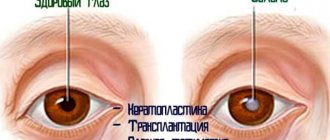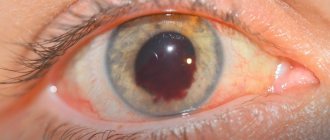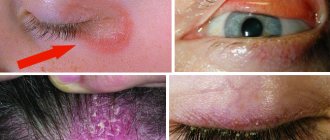What is demodicosis of the eye?
The development of demodicosis provokes the active reproduction of microscopic mites. Its dimensions are no more than 0.3 mm. Therefore, it cannot be seen by the human eye. It feeds on skin that is dying. It usually collects on the edge of the eyelids. This localization is ideal for the reproduction of this parasite. Such mites can remain in the body all their lives and not show characteristic signs.
Against the background of decreased immunity, lack of hygiene rules, and exposure to unsanitary conditions, pronounced symptoms of infestation by this mite are observed:
- severe burning and itching, which is localized in the eyelid area;
- eyelash loss;
- redness of the mucous membrane;
- dryness;
- yellow discharge from the eyes.
Symptoms may develop gradually and are not pronounced. Therefore, patients often ignore them and do not consult an ophthalmologist. Such signs occur when specks or small particles get into the eye. Lack of treatment contributes to the development of demodicosis and its spread to other organs.
Brief characteristics of the pathogen
Demodex mites are microscopic in size. Its length ranges from 0.2 to 0.5 mm.
It is often undetectable with the naked eye. It parasitizes the sebaceous glands and hair follicles, feeding on dead skin cells.
Normally, a tick can be present in every person and not manifest itself in any way until a certain time. That is why Demodex is considered an opportunistic pathogen.
Under certain conditions (decreased immunity, chronic diseases, etc.), the tick develops rapid vital activity and becomes the cause of a disease that can occur in the form of seborrhea, demodicosis of the eyelids (blepharitis), rosacea (rosacea), blepharoconjunctivitis (demodex of the eyes).
It should be noted that tick waste products are a strong allergen.
Causes
The main reasons for the development of demodicosis of the eyes:
- the disease tends to worsen in autumn and spring (during this period, a decrease in immunity and the development of allergic reactions are often observed);
- exposure to external factors - high air temperatures, hypothermia, radioactive radiation, working with chemicals and household substances;
- consequences of injuries and surgery;
- inflammatory processes;
- diseases of blood vessels, endocrine system, liver;
- bacterial and fungal diseases;
- hormonal imbalance;
- skin diseases: seborrhea, dermatoses, oily skin type;
- stress, nervous tension;
- long-term use of hormonal drugs.
The disease can be recognized by the following signs:
- stye, which occurs very often;
- severe itching, which may be accompanied by peeling;
- sticking and loss of eyelashes;
- eye fatigue, feeling of heaviness of the eyelids;
- feeling of sand in the eyes;
- swelling;
- increased lacrimation;
- increased sensitivity to light;
- dryness.
If any unpleasant symptoms develop, you should consult an ophthalmologist. This will help avoid the development of serious complications
demodex mite
Demodex mite on the eyes is a type of parasite that affects the follicles of the eyelashes.
Two types of this mite reproduce in the human body:
- Demodex folliculorum, which reproduces in or near the eyelash follicles;
- Demodex brevis, which is found less frequently and only in the sebaceous ducts of the eyelid.
But both of these species cause demodicosis - an inflammatory disease of the edge of the upper and lower eyelids.
The average size of a demodex mite is about 0.4 millimeters (adult).
The food for such a parasite is not only particles of eyelashes, but also particles of the skin of the eyelid and sebaceous secretions of the glands located here.
The mite reproduces quickly, laying eggs in the follicles, from which new individuals hatch within the next three days.
It is worth noting! The disease worsens not only with an increase in the number of ticks, but also due to inflammatory processes provoked by the decomposition of dead parasites.
Diagnostics
Initially, the patient should consult an ophthalmologist. It is important to listen to the patient’s complaints and study his medical history. After this, a visual inspection is carried out. Biomicroscopy is used to examine eyelashes. This will help detect the presence of scales.
If necessary, additional tests may be prescribed.
If the development of demodicosis is suspected, the first step is to analyze several eyelashes. If the diagnosis is confirmed, the doctor carefully examines the condition of the eyelashes under a microscope. Skin is also taken for analysis. Before this, the patient should not wash or use cosmetics.
It is precisely such surveys that are reliable. This is very important because this disease is accompanied by symptoms that are similar to other pathologies. It is forbidden to independently establish a diagnosis based on general information. If a person is faced with demodicosis, then he may need consultation with specialized specialists: a gynecologist, dermatologist, gastroenterologist, immunologist, infectious disease specialist.
Possible complications
Due to the parasitic activity of the parasite, inflammation of the eyelids, corneas of the organ of vision, and tumor-like formations can occur. In addition, mites are capable of releasing toxic decay products. Under their influence, demodicosis of the eyelids will lead to nervous disorders, depression and decreased self-esteem.
Medications
The doctor will be able to prescribe an effective medicine for demodicosis of the eyelids, taking into account the type and stage of the pathology, as well as the individual characteristics of the pathology.
For the effective treatment of demodicosis of the eyelids, there are a lot of effective drugs, presented in the form of ointments. Among them are the following popular means:
- Sulfuric ointment. This drug can disinfect, destroy parasites and speed up the healing process. Sulfur ointment is an effective, but inexpensive remedy. The only drawback is the unpleasant aroma and contamination of things. Use the ointment to treat the skin, avoiding contact with hair areas. The duration of treatment will be 7-12 days.
- Permethrin ointment. This is an insecticidal and acaricidal drug that has a local effect. Due to the active components that penetrate the parasite’s body, it is possible to quickly immobilize and destroy it. Skin treatment should be carried out 2-3 times a day. The duration of treatment is 14 days. The drug should not be used by children under 3 years of age.
- Ointment Yam. This dermatological medicine is based on components that are effective against parasites and fungi. Apply the ointment 2 times a day for 14 days.
- Ichthyol ointment. Its action is aimed at destroying pathogenic microflora and pain. Apply the drug 3 times a day.
Dexa-Gentamicin is described in this article.
If it is necessary to treat demodicosis of the eyelids on delicate skin, then you should pay attention to medications such as Blefarogel, Demalan, Zinc-ichthyl ointment. They are specially designed for delicate skin, as they do not irritate the mucous membranes and do not contain toxins.
To combat the disease, you can use drugs in the form of drops. But they should not be dripped, but used to treat the skin of the eyelids, since this is where mites live.
You need to drop the product onto a cotton swab and apply it to your eyelids. You can also massage with your finger. But to eliminate itching, dryness and inflammation, eye drops can be dripped into the conjunctival sac.
The treatment regimen may include the following acaricidal drops:
These products should be used not for instillation, but for treating the edges of the eyelids.
To treat demodicosis complicated by secondary infection, drops with an antibacterial effect are used. The following drops can be called effective:
- Levomycytinaceae,
- Levoflaxacin,
- Ciprofloxicin,
- Tobrex,
- Dexa-Gentamicin (ointment). Levomycetin, eye drops that will help cure demodicosis, more details here.
Also read about Ciprofloxin at this link.
To relieve the unpleasant symptoms of allergies on the eyelids, it is worth using antihistamine drops:
Folk remedies
To treat demodicosis of the eyelids, non-traditional remedies are used as often as pharmaceutical ones. The following recipes remain effective:
- Wormwood decoction. You need to take 40 g of raw materials, pour 1 liter of boiling water. Leave for 2-3 minutes. Take the filtered decoction 6 times a day, 50 ml. On the first day of therapy, take it every hour, then after 2 hours, and on the third day - after 3 hours.
- Aloe juice compresses. With the help of such compresses it is possible to relieve swelling and hyperemia. Take fresh leaves of the plant, wash, cut and apply the inside to the inflamed skin of the eyelids.
- Oak bark decoction. This remedy also effectively combats the unpleasant symptoms of demodicosis. You need to take 10 g of raw material and pour 200 ml of hot water. Leave for 30 minutes. Filter the broth, moisten cotton pads and apply to eyelids. Change them every 10 minutes.
- Calendula infusion. You can find it in the first aid kit. Apply to a cotton swab and treat the area around the eyelashes.
- To get rid of a tick, you can cleanse the entire body. Do this using a decoction of birch petals. Take them in an amount of 20 g and pour 200 ml of boiling water. Wait 30 minutes, filter and take 20 ml 3 times a day.
Folk remedies alone cannot cure demodicosis of the eyelids. So they should be used in combination with medications.
Treatment
There is a certain scheme that effectively helps to get rid of this disease. The patient is prescribed a diet, medications, and physiotherapy. Damage to the eyelids and eyelashes is treated with the same methods. Treatment regimen:
- maintaining hygiene;
- massage;
- physiotherapeutic procedures;
- antibacterial, anti-inflammatory, antiallergic drugs;
- ophthalmic drops with natural tear substitutes.
The treatment is effective, but long-term. It depends on the complexity of the lesion and the presence of complications. A favorable result can be observed within 1-2 months.
Diet
For this disease, doctors recommend eating large amounts of fruits, berries, and vegetables every day. Foods that increase blood circulation should be excluded from the diet: alcohol, coffee, strong tea, spicy foods.
In addition, you should reduce your intake of sugar and salt. The following foods should be excluded from the diet: citrus fruits, eggs, smoked meats, canned food, fried foods, cocoa and chocolate. It is recommended to replace them with fermented milk products, herbs, and vegetables. Among the drinks, compotes and fruit juices will be useful.
Massage
Massage refers to physiotherapeutic procedures. Additionally, magnetotherapy and electrophoresis are prescribed. You can perform a massage after hygiene procedures and treating the eyelids with antiseptic agents.
The patient must close his eyes. Use your fingertips to make circular movements along the upper eyelid. It is recommended to do it once a day for no longer than 15 minutes. After this, you can notice an accumulation of scales. They are removed with a sterile cotton swab. You can perform a massage only with clean hands.
Drug therapy
For the treatment of demodicosis, drugs of different groups are prescribed. Complex treatment provides a favorable result. It is important to follow the regimen prescribed by the doctor and strictly adhere to the prescribed dosage.
Drops
The use of drops is mandatory. Basically, substitutes for natural tears are prescribed for dryness and for its prevention. The following drops are considered effective: Natural tear, Slezin, Hyphenate.
Gels, ointments, creams
Among the gels I recommend using are Blepharogel and Differin. Ointments are usually prescribed with an antibiotic. For example, tetracycline or gentamicin ointment. Zinc ointment produces an anti-inflammatory effect. Combined creams – Demazol, Demalan. Additionally, you will need to treat the eyelids with an antiseptic solution (Furacilin, Chlorhexidine). It is worth considering that taking medications on your own is strictly prohibited.
Treatment of demodicosis of the eyelids in humans
The average duration of treatment for this serious disease is 1.5 months. If its form is advanced, this may take about 6 months.
Treatment should be comprehensive:
- Washing the eyes with tar soap, which is an excellent antiseptic and insecticide, helps.
- To remove fluid stagnant in the inflamed glands, a massage for the eyelids is necessary.
- Ticks become less mobile by rubbing the edges of the eyelids with alcohol tinctures of calendula or eucalyptus.
- It is necessary to lubricate the edges of the eyelids with drops of Carbohol at least 3 times a week, with the help of which the parasites are removed.
- Throughout the entire treatment therapy, it is necessary to apply Demolon eyelid demodicosis ointment, based on metronidazole, silver citrate, sulfur, burdock and mulberry. The procedure should be performed after waking up and before going to bed. It is important to avoid direct contact of the ointment with the eyes.
- Stopdemodex gel is effective in the fight against eye demodicosis. It contains metronidazole, hyaluric acid and chamomile. The gel is applied to the eyelids at the roots of the eyelashes, pre-treated with calendula tincture. After 30 minutes, the remaining medication is removed with a napkin. The procedure must be carried out in the morning and evening. The course is at least 1.5 months.
- The drug Blepharogel 2, consisting of hyaluronic acid, sulfur, glycerin, and aloe vera, has proven itself to be excellent in the fight against ticks. Using a cotton swab, the product is applied to the roots of the eyelashes. Then, using light movements, the eyelids are massaged for about 3 minutes. Morning and evening times are favorable for the procedure. You can do it daily.
- For greater effectiveness of treatment, ophthalmologists recommend the use of Levomycetin, Ciprofloxacin, Levofloxacin drops.
- In case of an advanced form of the disease or its frequent relapses, internal use of Metronidazole is necessary for a course of at least 10 days. This is an important condition in the fight against demodicosis.
- In case of allergies, which are often caused by mites, Dexamethasone or Diphenhydramine is prescribed.
Prevention
By following simple rules of prevention, you can significantly reduce the risk of developing demodicosis. Key recommendations include:
- Maintaining hygiene rules. Cosmetics must be individual.
- After visiting the bathhouse, it is recommended to wash with antibacterial soap.
- Use your own bed linen and towels. Wash them thoroughly and steam them.
- To refuse from bad habits.
- Maintain a healthy lifestyle, eat a healthy and balanced diet, and sleep at least 7 hours.
- The diet should contain a large amount of vitamins to improve immunity.
Timely diagnosis is the key to successful treatment. In addition, every person should be examined by an ophthalmologist 1-2 times a year.
Medications
Today, the following drugs are used to treat demodicosis on the face:
- Blepharogel;
- Metronidazole eye gel (1% or 2%);
- Demalan;
- Zinc-ichthyol ointment.
The drug blepharogel has gained the most popularity.
The fact is that it is made on the basis of sulfur - a product that perfectly fights mites and cleanses the ducts of the sebaceous glands from the waste products of this parasite. In addition, the drug contains hyaluronic acid, which accelerates the healing of damaged tissue and enhances local immune defense.
In the complex treatment of demodicosis, antihistamines (antiallergic) drugs can be used: lecrolin, diazolin and others.
To prevent secondary infection of the eyelids, broad-spectrum antibacterial drugs can be prescribed: tetracycline, tobramycin, okomistin, albucid.
How to cure demodicosis on a person’s face and eyelids using ointments and drops can be found in detail below.
Ointments
To cure demodicosis, doctors prescribe many medications, the most effective include ointments.
Sulfur ointment for demodicosis is a drug that disinfects, destroys parasites, and accelerates healing. An effective and cheap product is very popular. Minus – unpleasant smell, contamination of things. Apply the ointment to the skin, avoiding hairy areas. Therapeutic course – from 7 to 12 days.
Permethrin ointment for demodicosis is an insecticidal and acaricidal agent with local action. The active components of the drug penetrate the tick's body, immobilize and destroy it.
The facial skin is treated 2-3 times a day, avoiding hair. The duration of the therapeutic course is 2 weeks. Do not use on patients under 3 years of age.
Yam ointment for demodicosis of the face and eyelids for humans is a dermatological preparation, the components of which are effective against parasites and fungi. Frequency of use – 2 times per day, course duration – 2 weeks. Your doctor will advise you on the rules of application.
Ichthyol ointment destroys bacteria, disinfects, and eliminates pain. The affected skin is treated three times a day.
There are drugs for the treatment of demodicosis in humans on the eyelids and eyes: Blefarogel, Demalan, Zinc-ichthyl ointment, etc. These drugs are created specifically for the delicate skin of the eyelids, they do not irritate the mucous membrane of the eyes, and do not contain a large amount of toxins that are absorbed into the blood.
Drops
Another effective remedy for combating Demodex mites is eye drops. The habitat of parasites is the edges of the eyelids, so only the skin around the eyelashes is treated with drops.
Apply a few drops of anti-demodectic mange to your fingertips and massage your eyelids. The drug is instilled into the conjunctival sac only if the patient has itching, dryness and inflammation.
Acaricidal eye drops have proven themselves to be excellent: Carbochol, Physostegmin, Phosphacol. These are exactly the products that are used to treat the edges of the eyelids, and not for instillation.
Demodicosis complicated by secondary infection must be treated with antibacterial drops. The most effective drugs: Levomycytin drops, Levoflaxacin, Ciprofloxicin, Tobrex, Dex-Gentamicin, etc.
To relieve itching and other symptoms of allergies on the eyelids, use antihistamines: Acular, Okumetil, Dexamethasone.
Eyelid massage
Eyelid massage is a very important component of treatment, as it helps cleanse the glands of pus and dead skin cells. It is recommended to massage for 5-10 minutes before each application of the drug.
Demodicosis of the eyelids and cosmetics
During the illness, you must stop using all cosmetics.
This is important for the following reasons:
- Microscopic particles from mascara and other products can clog the gland ducts and further aggravate the disease;
- Any cosmetics (even the most expensive and high-quality ones) can cause increased allergic reactions;
- Cosmetics create favorable conditions for the growth and reproduction of demodex.
In order to prevent relapse, you need to throw away all the cosmetics that you used before the onset of the disease. The fact is that mites can persist for a long time both on the cosmetics themselves and on applicators and brushes for applying makeup.
